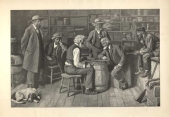The Checker Maven
The World's Most Widely Read Checkers and Draughts Publication
Bob Newell, Editor-in-Chief
Published every Saturday morning in Honolulu, Hawai`i
Noticing missing images? An explanation is here.
The Devil and the Deep Blue Sea

We have to admit that last month's Fausto Dalumi problem was well into the "difficult" category. So this month, we'll feature a problem that is a little less strenuous. It was originally published under the theme "The Devil and the Deep" and we think you'll see why when you arrive at the solution.
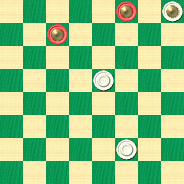
WHITE
White to Play and Win
W:W27,15,K4:BK6,K3
We don't think this problem will sink you, but if you find yourself bedeviled, just click on Read More and the solution will surface.![]()
Overlooked by Mail

Roughly once a month, we present an excerpt from Willie Ryan's undisputed classic work of checker tactics, Tricks Traps & Shots of the Checkerboard, and it's proven to be one of our most popular ongoing features. This time Willie turns to the world of postal play with a surprising game. Here's how Willie describes things.
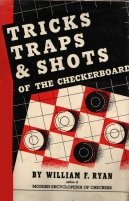
"The similarity of formation and procedure between the preceding example (a Paisley Shocker) and the one ultimately reached in the accompanying game can be identified readily by comparing the two positions at the diagrammed stages. If there is any doubt in the reader's mind that champions are constantly overlooking winning strokes in their play, consider the circumstances in the case at hand. Two of America's foremost mail-game exponents--- Victor Davis, of Fort Dodge, Iowa, and George W. Bass, of Eaton, Colorado--- played this game by mail. When the diagrammed situation was reached, both contestants muffed the killer, the game ending in a draw.
| 10-15 | 27-20 | 1-5 |
| 24-19 | 4-8 | 30-25 |
| 15-24 | 17-13 | 3-8 |
| 28-19 | 2-6 | 22-17 |
| 9-14 | 31-27 | 14-18 |
| 22-18 | 8-11---A | 17-14 |
| 5-9 | 29-25---B | 11-15 |
| 25-22 | 10-15* | 20-16---C |
| 6-10 | 25-22 | 8-12 |
| 22-17 | 15-19 | 21-17---D. |
| 11-15 | 23-16 | See the |
| 18-11 | 12-19 | diagram. |
| 8-24 | 32-28 |

BLACK
Black to Play and Win
B:W28,27,26,25,17,16,14,13:B19,18,15,12,9,7,6,5.
A---Of course, 10-15 loses immediately by the in-and-outer via 21-17, 14-21, 30-25, 21-30, 20-16, 12-19, 23-16, 30-23, 27-2, 8-12, 16-11, 12-16, 29-25, 16-19, 32-27, etc., and white wins. Again at A, if black moves 1-5, white will win with: 23-18, 14-23, 27-18, 8-11, 29-25, 10-15, 26-22, 7-10, 21-17, 12-16, 32-27, 3-8, 30-26, 8-12, 18-14, 9-18, 26-23. Wm. F. Ryan.
B---23-18 would be no good now. For example: 23-18, 14-23, 27-18, 10-14, 26-23, 7-10, 29-25, 10-15, 25-22, 12-16, 32-28, 15-19, 30-26, 3-8, 18-15, 11-27, 20-4, 1-5, etc., and black wins. Wm. F. Ryan.
C---A safer route would be 21-17, 6-10*, 13-6, 19-24, 28-19, 15-31, 26-22, 8-12, 22-15, 10-19; a draw.
D---This is where Bass bogged down in the morass of formation. The move taken allows the thunderbolt that follows; but instead of 21-17, try 16-11*, 7-16, 26-22, 19-23, 14-10, 23-32, 10-1, 9-14, 22-17, for a draw. Wm. F. Ryan."
Don't get buried yourself. After you've tried to solve the position, dig your way out by clicking on Read More to see the solution.![]()
Saving the Game

In this month's lesson in our ongoing Checker School series, we learn a valuable lesson in saving the game; in other words, looking for a way to draw even when our position doesn't appear to have too many chances. Here's the position:
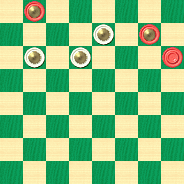
BLACK
Black to Play and Draw
B:WK26,K24,K23:BK32,K25,21.
This situation, attributed to a J. Cornock, does indeed look tough for the Black side, who have little mobility and a very narrow choice of moves. Yet, one of them is good enough to save the draw. Can you find it?
Give it a try but don't forget, you can always save time and frustration by clicking on Read More to see the solution, with detailed notes and a sample game.![]()
Faster Than Greased Lightning

Our first set of speed problems for the year are truly worthy of the title. They both fall decidedly into the "easy" category, but as we know our readers enjoy a challenge, we're setting the time limits at record lows--- five seconds for the first problem and ten seconds for the second! We think this should satisfy everyone. Advanced players can try to sight-solve the problems in the rather strict time limits allotted. Less experienced players can simply look for the solutions and ignore the clock (well, yes, that is easier said than done).
Are you ready? Click below to start each problem--- faster than greased lightning!
February Speed Problem No. 1 (five seconds)
February Speed Problem No. 2 (ten seconds)
When you're finished, slide your mouse over and zap Read More to see the solutions.![]()
What's Your Call?
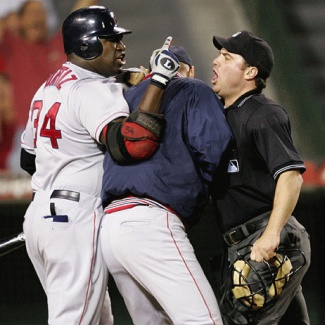
In the world of sports, sometimes a play is a really close call and quite an argument about it takes place. Today's checker problem surely falls into that category. Take a good look at the position below, with White to move. How would you call this one? White win, Black win, or draw? Show it to your checker friends and you're bound to generate a lot of, shall we say, animated discussion (we'd hate to accuse checker players of having heated arguments, after all).
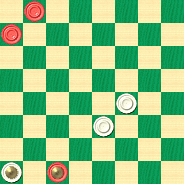
WHITE
White to Play, What Result?
W:WK29,23,19:BK30,5,1.
Make the call, and then do an "instant replay" to demonstrate the correctness of your decision. We'll just give you a bit of fair warning: this one isn't so easy, and just may surprise you. What do you say?
There's one call, though, we can always make without error: it's a certainty that clicking on Read More will bring you to the solution.![]()
A Paisley Shocker

Our popular series of extracts from Willie Ryan's Tricks Traps & Shots of the Checkerboard continues this month with a shot flashy enough to be worthy of the great Bronx Comet himself. Here is how Willie describes it.

"The idea shown in the adjoining example occurs in several mid-game structures, and belongs to the vast family of in-and-out strokes. The first move in some coups is so startling and unexpected that players have been known to fall out of their chairs in sheer surprise! This one has unseated quite a few staunch sitters!
| 11-16 | 28-24 | 10-17 |
| 24-19 | 8-12 | 21-14 |
| 8-11 | 31-27 | 2- 6 |
| 22-18 | 6- 9 | 18-15 |
| 4- 8 | 26-23 | 9-18 |
| 18-14 | 1- 6 | 23-14 |
| 9-18 | 25-21 | 3- 8 |
| 23-14 | 16-20 | 25-22 |
| 10-17 | 30-26 | 16-19 |
| 21-14 | 11-16 | 22-18 |
| 16-23 | 32-28 | 12-16---A |
| 27-18 | 6-10 | See the |
| 12-16 | 29-25 | diagram. |
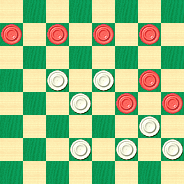
WHITE
While to Play and Win
W:W14,15,18,24,26,27,28:B5,6,7,8,16,19,20.
A---Gone with the wind. Black's proper play for a draw is: 19-23, 26-19, 7-11, 19-16, 12-19, 14-10, 6-9, 10-7, 19-23, 7-3. Sam Levy, Manchester, England."
Can you solve this one, or will you get zapped instead? In either case, clicking on Read More will charge on over to the electrifying solution.![]()
On the Edge

In today's Checker School installment, we have a position that is literally "on the edge" with nearly all of the pieces starting out on the edges of the board. It's yet another instance where you think the win ought to be clear; after all, Black seems to have real superiority here---- or does he?
We certainly don't call this an easy problem. The win is fairly long and involved and concludes with an elegant tableau, and it might be a bit of a challenge for you to find the solution. Here's the position.
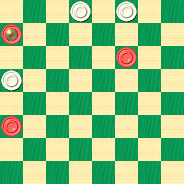
BLACK
White to Play, Black Wins
W:W31,30,20:BK28,22,12.
Can you edge your way to victory, or will you go over the edge instead? There's no need to worry; clicking on Read More will take the edge off your anxieties by bringing you a detailed solution with copious notes, and a sample game as well.![]()
The Bizarre World of Strokes

We haven't run a "stroke" problem in a little while, though it's something we like to do for the sake of variety on the first Saturday of some months. Today we return to that theme, and present a problem that was considered "easy" by the author.
Much as the photo above represents the bizarre side of architecture, stroke problems are certainly the bizarre side of the world of checkers. You either love them or hate them, and we think that depends in no small measure on whether you're able to solve them. Stroke problems call upon your ability to visualize long, forced series of moves. They are an excellent test of your skills, but seldom, if ever, an exercise in practical play.
So here's our so-called "easy" problem.
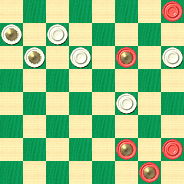
WHITE
White to Play and Win
W:WK5,6,K9,10,12,19:B4,K11,K27,28,K32..
Could you find your way through, or is all simply too bizarre? Whatever your result, click on Read More to see the "easy" solution. Did we say "easy"? You may or may not agree!![]()
One for New Year's Eve

Are you celebrating the upcoming New Year's Eve on an elegant cruise ship off the coast of O`ahu? Well, don't feel bad, we're not either (though maybe some day we might). We'll likely stay home in our Honolulu location and watch the goings on from our lanai.
We'd like to present you with an alternative, though, to parties and dancing. We have a checker problem that is difficult enough to carry you through the evening and into the early hours of the morning. It's non-alcoholic, doesn't require driving or pushing your way through a crowded dance floor, and is completely free. What else can you find on New Year's Eve that doesn't come with a stiff price tag? (That's why we're skipping the cruise this year, in fact; at nearly $300 per person we'd much rather play checkers instead.)
Here is a position that even champion Tom Wiswell called "challenging."
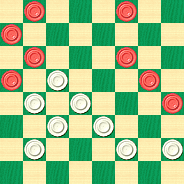
WHITE
White to Play and Draw
W:W28,27,25,23,22,18,17,14:B20,16,13,11,9,5,3,1.
Can you cruise to a solution this New Year's Eve, or even sooner? There's no need to wait, though; clicking on Read More will ensure a smooth voyage straight to the answer.![]()
A Souter Six-Shooter

As we continue to republish the unequalled classic Tricks Traps & Shots of the Checkerboard we today find author Willie Ryan ready for a real shoot-em-up. It's one we're sure you'll enjoy. Willie tells us all about it below.

"The ancient Souter opening, formed by 6-9 at the fifth move of the game tabulated below, was a great favorite with all the champions in Wyllie's day. According to historians, the opening was named after a Scottish shoemaker who knew his way around with it. Here's a Souter snare that will shake the crown from any king:
| 11-15 | 24-20 | 10-14---B |
| 23-19 | 15-24 | 19-10 |
| 9-14 | 28-19 | 6-15 |
| 22-17 | 11-15 | 13-9 |
| 6-9---A | 27-24 | 14-18 |
| 17-13 | 14-17 | 23-14 |
| 2-6 | 21-14 | 7-11 |
| 25-22 | 9-18 | 31-26 |
| 8-11 | 26-23 | 12-16---C, |
| 29-25 | 18-27 | forming |
| 4-8 | 32-23 | the |
| diagram. |
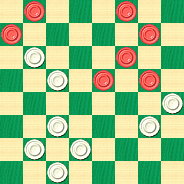
WHITE
White to Play and Win
W:W9,14,20,22,24,25,26,30:B1,3,5,8,11,15,16.
A---The Souter opening, a standard debut leading to an equal game.
B---A good "catch" line for black is 5-9. After this move, 23-18, 8-11, 20-16, 11-27, 18-2, 27-32, etc., leads to a draw; but if white plays 25-21 after 5-9, then black scores with this impressive combination: 5-9, 25-21, 9-14, 21-17 (all that's left), 14-21, 23-18, 8-11, 31-27 (31-26, 3-8 wins), 11-16*, 20-2, 1-5, 18-11, 3-7, 2-9, 7-32, 9-6, 32-28, 6-15, 28-10. W. S. Lambert. A real beauty.
C---Well-known play to here. The text loses by the pending shot. The correct moves are: 3-7*, 25-21, 15-19, 24-15, 11-25, 9-6, 1-17, 21-14, 8-11 *, leading to a draw."
Were you quick on the draw in finding the solution? Don't be blown away; click on Read More to shoot directly to the solution.![]()
The Checker Maven is produced at editorial offices in Honolulu, Hawai`i, as a completely non-commercial public service from which no profit is obtained or sought. Original material is Copyright © 2004-2025 Avi Gobbler Publishing. Other material is public domain, as attributed, or licensed under Creative Commons. Information presented on this site is offered as-is, at no cost, and bears no express or implied warranty as to accuracy or usability. You agree that you use such information entirely at your own risk. No liabilities of any kind under any legal theory whatsoever are accepted. The Checker Maven is dedicated to the memory of Mr. Bob Newell, Sr.

